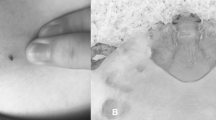Summary
The paper records unsuccessful attempts to transmitT. mutans andB. bigemina using adultR. appendiculatus fed as nymphs on cattle demonstrating parasitaemias of the appropriate parasite, and ofT. parva by adultR. evertsi fed in their immature stages on a steer demonstrating piroplasms ofT. parva. An analysis of the pertinent literature casts some doubt as to the significance of the two species of ticks referred to in the transmission of these parasites, particularly under field conditions.
Résumé
Cet article rapporte les essais infructueux de transmission deT. mutans et deB. bigemina au moyen de tiques adultesR. appendiculatus nourries au stade nymphal sur des bovins ayant des parasitémies positives de l’agent approprié, et deT. parva au moyen d’adultesR. evertsi nourris pendant leurs phases immatures sur une génisse infectée parT. parva. Une analyse des publications pertinentes sur ce sujet jette quelque doute sur la réalité du pouvoir de transmission attribué à ces deux espèces de tiques, au moins dans les conditions naturelles.
Sumario
Se registran en el trabajo intentos sin éxito para transmitirT. mutans yB. bigemina usandoR. apendiculatus adultos alimentadas cuando ninfas en ganado vacuno con parasitemias del parásito en cuestión, y deT. parva porR. evertsi adultos alimentados en sus estadíos inmaduros en un novillo con piroplasmas deT. parva. Un análisis de la literatura pertinente arroja cierta duda sobre el significado de las dos especies de garrapatas referidas en la transmisión de los parasiton en cuestión, particularmente bajo condiciones de campo.
Similar content being viewed by others
References
Bailey, K. P. (1960). ‘Notes on the rearing ofRhipicephalus appendiculatus and their infection withTheileria parva for experimental transmission’.Bulletin of Epizootic Diseases of Africa,8, 33–43.
Cowdry, E. V. &Ham, A. W. (1932). ‘Studies on East Coast Fever. I. The life cycle of the parasite in ticks’.Parasitology,24, 1–49.
Fotheringham, W. &Lewis, E. A. (1937). ‘East Coast Fever: Its transmission by ticks in Kenya Colony.Hyalomma impressum nearPlanum P. Sch., as a vector’.Parasitology,29, 504–521.
Lounsbury, C. P. (1906). ‘Ticks and African Coast fever’.Agricultural Journal of the Cape of Good Hope,28, 634.
Montgomery, R. E. (1913). ‘Diseases of cattle’. Report of the Department of Agriculture, Nairobi, British East Africa (1911–1912) pp. 37–39.
Neitz, W. O. (1938). As quoted by Neitz, W. O. (1956).
Neitz, W. O. (1956). ‘A consolidation of our knowledge of the transmission of tick-borne diseases’.Onderstepoort Journal of Veterinary Research,27, 115–163.
Neitz, W. O. (1957). ‘Theileriosis, Gonderioses and cytauxzoonoses: A review’.Onderstepoort Journal of Veterinary Research,27, 275–430.
Neitz, W. O. (1959). “Theileriosis’.Advances in Veterinary Science,5, 241–297.
Neitz, W. O. & Jansen, B. C. (1950). As quoted by Neitz (1965).
Nuttall, G. H. F. &Fantham, H. B. (1909). ‘Observations onTheileria parva, the parasite of East Coast fever of cattle’.Parasitology,2, 325–340.
Purnell, R. E. &Joyner, L. P. (1967). ‘An artificial feeding technique forRhipicephalus appendiculatus, and the transmission ofTheileria parva from the salivary secretion’.Nature, London,216, 484–485.
Theiler, A. (1907a). ‘Further notes onPiroplasma mutans—a new species ofPiroplasma in South African cattle. Part II’.Journal of Comparative Pathology and Therapeutics,20 1–18.
Theiler, A. (1907b). ‘Further transmission experiments with East Coast fever’.Transvaal Agricultural Journal,6 413–425.
Theiler, A. (1909). ‘Transmission des spirilles et des piroplasmes par differentes éspèces de tiques’.Bulletin de la Société de Pathologie Exotique,2, 293–294.
UNDP/SF Project 300, (1969). The preparation of a suspension of the infective particles (I.P.’s) ofTheileria parva from infected ticks. East African Veterinary Research Organisation Ann. Rep. 1968, pp. 23–24.Bulletin of Epizootic Diseases of frica,15, 189–212.
Yeoman, G. H. (1967). ‘Field vector studies of epizootic East Coast fever. IV. The occurrence ofR. evertsi, r. pravus, R. simus andR. sanguineus in the East Coast fever zones’.Bulletin of Epizootic Diseaes of Africa,15, 189–212.
Author information
Authors and Affiliations
Rights and permissions
About this article
Cite this article
Purnell, R.E., Branagan, D. & Brown, C.G.D. Attempted transmission of some piroplasms by rhipicephalid ticks. Trop Anim Health Prod 2, 146–150 (1970). https://doi.org/10.1007/BF02359681
Accepted:
Issue Date:
DOI: https://doi.org/10.1007/BF02359681




